Terms of operation of frame houses: frame-frame, panel buildings, advantages and disadvantages of frame houses, the effect of thermal conductivity of materials on the service life
As you know, modern technologies for the construction of prefabricated houses have developed so much that such buildings in Russia appear more and more every year. The frame house is the cheapest, and the terms of its construction usually do not exceed 2 months, and most often one month is enough. The shield house can be found both in remote villages and in elite settlements near Moscow. An important issue that worries many is the service life of a frame house and the features of its operation. This issue will be discussed in detail in this article.
The minimum and maximum life of the house in various conditions
As for the service life of a wooden house built using frame technology, the technical instruction for the house kit says, like GOST of Russia, that this period is exactly 75 years. But this is purely technical data.
In practice, it turns out that the service life of buildings of this type is approximately one century, that is, 100 years. And it doesn’t matter whether such a house was built in the south of Russia or in the north (such houses will differ according to the insulation technology, but the service life of the frame house will be the same).
Scheme of the optimal arrangement of a frame house
After the expiration of the operational period (the same 75 years), the house does not need to be demolished: it will be necessary to repair the walls and facade to the level of windows, as well as completely replace the mortgage beam. As for the roofing material, it must be changed about once every 30 years.
Natural clay tiles or shingles can be changed every 50 years, but with metal tiles and corrugated board this will not work: a maximum of 30 years. By the way, the maximum service life of slate is 30 years, and if it is painted, it can last 40-50 years.
But when the house is already more than 100 years old, then it is simply impractical to do a major overhaul. It's best to just tear it down and build a new one. In fact, it is not yet clear what state the frame house will be in after such an amount of time.
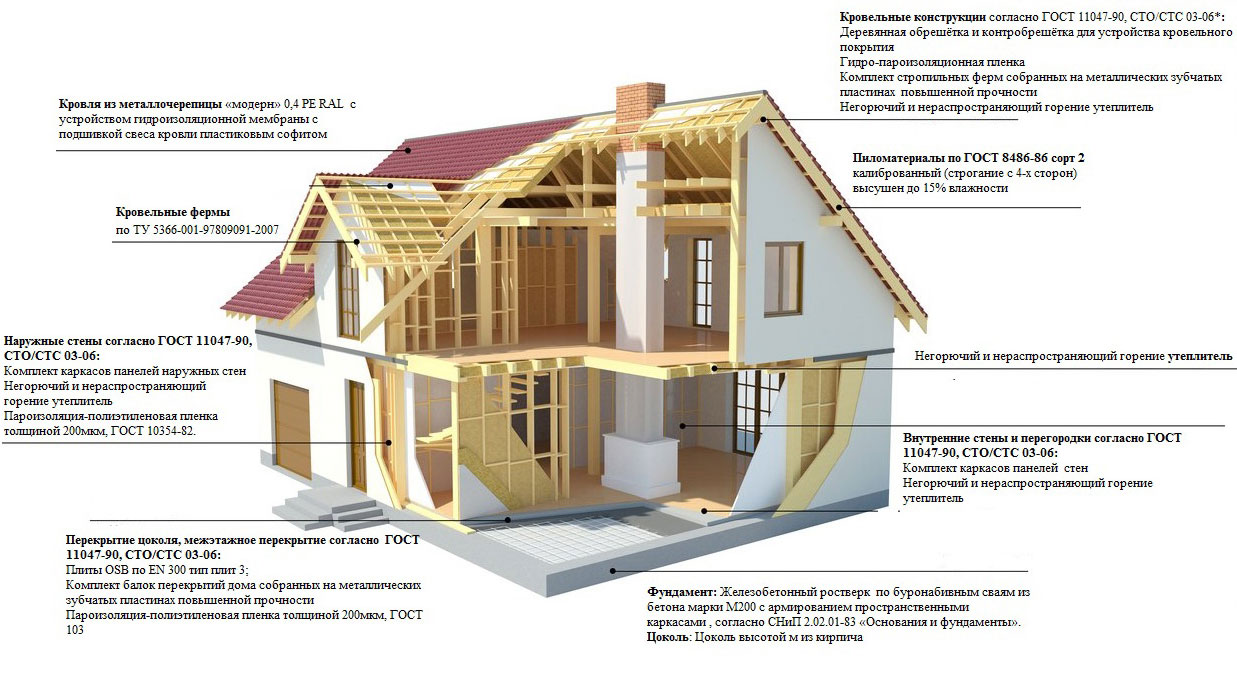
 The device of a frame house built according to Canadian technology
The device of a frame house built according to Canadian technology The fact is that they began to be built in the mid-1960s. Therefore, even the very first frame house will reach the age of 100 years only in the 2060s, and this is a very long time.
Roofing material in frame houses must be replaced approximately every 30 years.
Frame houses
In terms of operation, frame-frame houses are more durable than ordinary panel houses, but the difference is about 10-20 years, which is not so much, given that a building can stand for more than a century. In order for such a structure to last as long as possible, great attention must be paid to the insulation and sheathing that will cover the frame.
In particular, attention should be paid to the following nuances:
- it is not recommended to use chipboard boards for sheathing, as they have very little moisture resistance (OSB-3 boards are the best option);
- it is not recommended to use expanded polystyrene as a heater (especially loose, and not slab, which is extruded, since the latter emits formaldehyde, which is extremely harmful to the human body when exposed to high temperatures, and the material does not differ in high fire resistance);
- for insulation, it is best to use slab heat-insulating materials based on basalt fiber (such insulation is durable and absolutely does not harm human health, even if it is exposed to really high temperatures).

 Characteristics of mineral wool insulation, on which the final service life of a frame house depends
Characteristics of mineral wool insulation, on which the final service life of a frame house depends
In general, if you choose between a frame-frame house and a frame-panel house, then it is better to give preference to the first, if the durability of the building is important to the owner.
Frame-frame houses have a longer service life than panel houses.
Panel houses
Materials for panel houses are produced only in the factory, the term for the construction of such a house using the latest technology is a maximum of 2 weeks. Due to such a high speed of construction, builders may make some shortcomings that will adversely affect the durability of the structure.
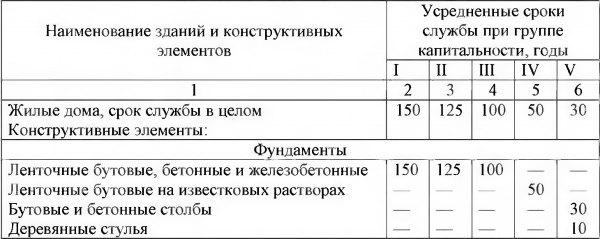
 Average service life of dloms and main structural elements of residential buildings
Average service life of dloms and main structural elements of residential buildings The walls of such a building (sandwich panels) consist of several layers:
- frame;
- thermal insulation material;
- vapor barrier;
- waterproofing agent;
- internal and external cladding (most often - using the OSB-3 boards mentioned above).
The roof is also a sandwich panel. For houses built using panel technology, assembly instructions are always issued. However, alas, it will not work to assemble such a structure with your own hands: it will require the involvement of special equipment such as tower cranes.
It is not worth hiring equipment and work teams separately: it will be much more expensive than just ordering a turnkey house. Particular attention should be paid to the heater. It is best if it is mineral stone wool or basalt-based heat-insulating material. Ecowool will be less durable, not to mention expanded polystyrene and similar heat insulators.
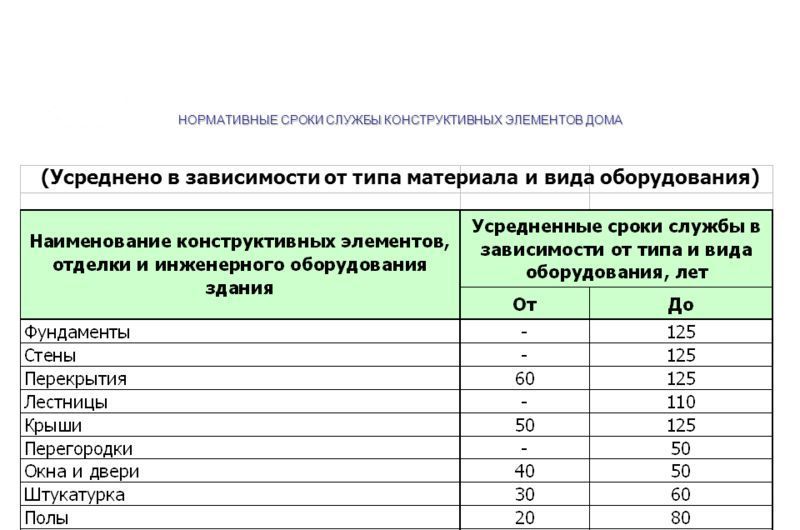
 Regulatory service life of the main elements of the house
Regulatory service life of the main elements of the house Advantages of frame houses
Among the advantages of houses built using frame technology, the following can be distinguished:
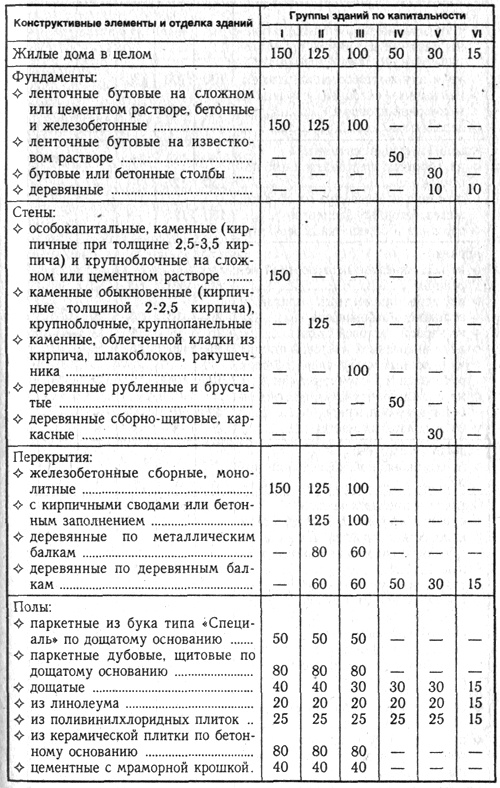
Disadvantages of frame houses
Of course, houses built using frame technology also have some disadvantages:
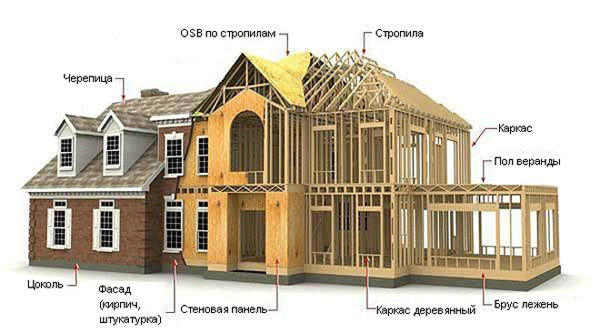
The load on the foundation, which gives the frame house, is only 700-800 kg per 1 m³.
Thermal conductivity of house wall materials and its impact on the service life
As noted above, the walls of the frame house themselves, without the presence of insulation, really have a rather high heat conductivity (this is bad, since it simply evaporates into the street). Of course, if you build any wooden house without insulation, the current life of its operation will decrease by 2-3 times!
But this can only be done in tropical and equatorial countries, where there are simply no harsh winters (and winters in general). But in Russia this problem exists. So, the problem was relevant in the days of the USSR, when frame houses were just beginning to be built, because then there were no high-quality heaters.
As for modern materials, slabs made on the basis of basalt fiber have the greatest resource in terms of ensuring durability.
Of course, such a heat-insulating material is expensive, however, its performance is at the highest level. Loose insulation is not used in the outer walls of buildings (sackwich panels). Expanded polystyrene, even slab, is also not recommended.
Video
You can watch a short video that talks about the service life of a frame house.
